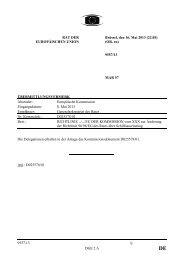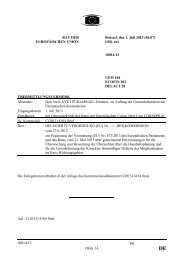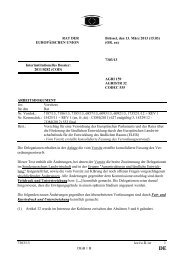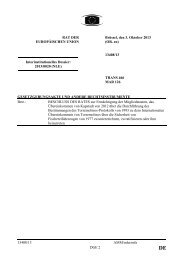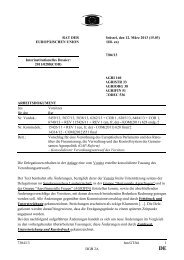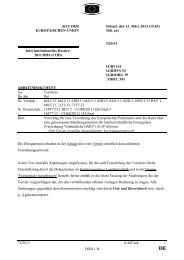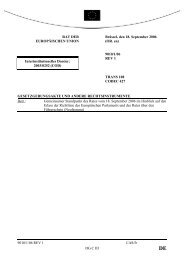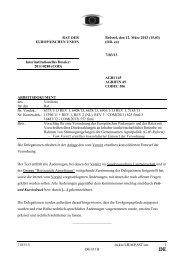17107/12 FL/ne 1 DG E 2 A COU CIL OF THE EUROPEA U ... - Europa
17107/12 FL/ne 1 DG E 2 A COU CIL OF THE EUROPEA U ... - Europa
17107/12 FL/ne 1 DG E 2 A COU CIL OF THE EUROPEA U ... - Europa
Create successful ePaper yourself
Turn your PDF publications into a flip-book with our unique Google optimized e-Paper software.
(11) Based on an analysis of the transport infrastructure plans of Member States, the Commission<br />
estimates that investment <strong>ne</strong>eds in transport amount to EUR 500 billion in the entirety of the<br />
TEN-T <strong>ne</strong>twork for the period 2014-2020, of which an estimated EUR 250 billion will <strong>ne</strong>ed<br />
to be invested in the core <strong>ne</strong>twork of the TEN-T. Given the resources available at Union level,<br />
concentration on the projects with the highest European added value is <strong>ne</strong>cessary to achieve<br />
the desired impact. Support should therefore be focussed on the core <strong>ne</strong>twork (in particular,<br />
the core <strong>ne</strong>twork corridors) and on the projects of common interest in the field of traffic<br />
management systems (notably the air traffic management systems resulting from SESAR<br />
which require Union budgetary resources of about EUR 3 billion).<br />
(<strong>12</strong>) Within the framework of the TEN-T policy review launched in February 2009, a dedicated<br />
expert group was created to support the Commission and look into the issue of the funding<br />
strategy and financing perspectives for the TEN-T. Expert Group No 5 drew from the<br />
experience of external experts from various fields: infrastructure managers, infrastructure<br />
plan<strong>ne</strong>rs, national, regional and local representatives, environmental experts, academia, and<br />
private sector representatives. The final report of Expert Group No 5 10 adopted in July 2010<br />
contains 40 recommendations, some of which have been taken into account in this proposal.<br />
(13) Experience with the current financial framework shows that many Member States, which are<br />
eligible to the Cohesion Fund, are facing significant obstacles in delivering on time complex<br />
cross-border transport infrastructure projects with a high Union added value. Therefore, in<br />
order to improve the delivery of transport projects, in particular cross-border o<strong>ne</strong>s, with a high<br />
Union added value, part of the Cohesion Fund allocation (EUR 10 billion 11 ) should be<br />
transferred to finance transport projects on the transport core <strong>ne</strong>twork in the Member States<br />
eligible to the Cohesion Fund under the Con<strong>ne</strong>cting Europe Facility. The Commission should<br />
support Member States eligible to the Cohesion Fund to develop an adequate pipeli<strong>ne</strong> of<br />
projects in order to give greatest possible priority to the national allocations under the<br />
Cohesion Fund.<br />
10 http://ec.europa.eu/transport/infrastructure/ten-t-policy/review/doc/expertgroups/expert_group_5_final_report.pdf.<br />
11 In 2011 prices.<br />
<strong>17107</strong>/<strong>12</strong> <strong>FL</strong>/<strong>ne</strong> 8<br />
ANNEX <strong>DG</strong> E 2 A E




